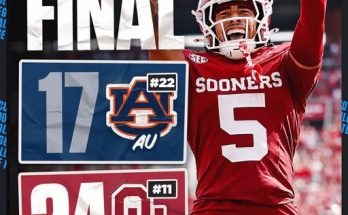Former Oklahoma pitcher Paytn Monticelli transferring to LSU is one of the more intriguing moves in the ever-shifting landscape of college softball, a sport that has grown rapidly in visibility and competitive fire over the last decade. This move, while it may appear like a routine transfer on the surface, is deeply layered. It’s packed with implications about development, opportunity, roster depth, and most critically, the pursuit of championships. Monticelli is not just another name in the transfer portal; she’s a young pitcher with a high ceiling who’s shifting from the most dominant program in college softball history to another perennial contender in LSU. That transition sets the stage for a new chapter not just in her career, but in the broader landscape of SEC vs Big 12 battles, player development philosophies, and how top-tier programs manage talent overload.
Monticelli arrived at Oklahoma with no shortage of fanfare. A 6-foot-tall right-hander from Wisconsin, she was among the top prep pitchers in her class, a highly-rated signee with the tools to grow into a major contributor at the college level. Her fastball has touched the low 70s, her movement is lively, and her composure in the circle has long impressed coaches and scouts alike. She chose Oklahoma not just because it was a winning program, but because it was the program—the dynasty under Patty Gasso that had become the gold standard of college softball, collecting national championships with what seemed like ruthless efficiency.
However, as with all dynasties, Oklahoma’s success breeds both opportunities and complications. The Sooners’ roster is stacked every year. They routinely bring in multiple All-Americans, top-ranked recruits, and high-level transfers. That depth creates a hyper-competitive environment where playing time is at a premium, especially in the circle. For pitchers like Monticelli, who enter the program with talent but require development time to polish mechanics, enhance pitch sequencing, and adjust to elite collegiate hitting, the runway to earn meaningful innings can be short.
During her time at Oklahoma, Monticelli saw limited action. She appeared in a handful of games, often in non-conference blowouts or low-leverage situations. The limited innings don’t reflect a lack of potential; rather, they underscore the difficulty of carving out a role when competing against a staff loaded with veterans and proven stars. Players like Jordy Bahl, Nicole May, and Kelly Maxwell occupied the top spots in the rotation, making it hard for younger pitchers to break through unless they were immediately dominant.
With Bahl having transferred to Nebraska and other staff changes occurring, some expected that Monticelli might have a clearer path in Norman. But college athletes are often evaluating their careers on shorter timelines now, especially with the growing importance of NIL and exposure. The longer a player remains underutilized, the more pressure there is to find a better fit—somewhere they can throw more consistently, face high-level competition, and develop under a slightly different coaching lens. LSU provides that new opportunity.
The Tigers are a top-tier SEC program that has been competitive nationally for years under Beth Torina, a former pitcher herself who has built her team around strong defense, aggressive base running, and, crucially, elite pitching. LSU’s pitching staff in recent years has featured a mix of home-grown talent and transfers. The program has proven it can develop pitchers and elevate them to All-SEC levels. For a player like Monticelli, that’s the kind of environment that offers both immediate opportunity and long-term promise.
LSU’s pitching situation entering the upcoming season is one that invites fresh competition. The Tigers have talent, but they haven’t had a dominant ace since the days of Carley Hoover and Allie Walljasper. They’ve had solid production, but not necessarily the kind of elite, overpowering rotation that makes postseason runs easier. With Monticelli’s transfer, LSU gets a young arm with the potential to grow into that kind of presence. And unlike Oklahoma, where she was one of several elite pitchers waiting for a breakout, LSU might allow her to move more quickly into a prominent role, especially if she impresses early in fall ball and preseason training.
Monticelli’s decision also reflects a broader truth about modern college softball: the transfer portal is now central to roster building. Programs no longer rely solely on four-year development plans. Coaches are constantly reshaping their teams, and athletes are far more willing to seek greener pastures when their current situation doesn’t offer what they need. For some, that’s about playing time. For others, it’s about coaching fit, team culture, or simply the chance to be closer to home. In Monticelli’s case, the move from Oklahoma to LSU likely reflects a combination of all those factors. She’s moving from a program that’s just finished a historic three-peat NCAA title run to one that’s hungry to get back to the Women’s College World Series spotlight.
There’s also something uniquely compelling about the timing. Oklahoma is moving to the SEC beginning in 2025, meaning Monticelli, had she stayed, would still have ended up in the same conference as LSU. Now, instead of facing an uphill battle to find innings for the Sooners, she’ll be trying to help LSU take down her former team. That adds spice to an already intense conference and gives her a compelling narrative as she tries to prove herself on the biggest stages in college softball.
From a development standpoint, the move to LSU could be transformational for Monticelli. Torina and her staff are known for their technical approach to pitching. They emphasize mechanics, location, and strategic pitching over pure velocity. That may suit Monticelli well as she matures and builds out her arsenal. At Oklahoma, the expectations are sky-high from day one; at LSU, while the pressure is still immense, the path to growth can be more personalized. For a pitcher who hasn’t yet logged significant innings, that kind of environment could unlock the next level of her potential.
Additionally, LSU’s fan base is one of the most passionate in the SEC. Tiger Park is known for its rowdy crowd, loyal supporters, and an environment that mirrors the intensity of the football program. That kind of support can energize a player, especially one who’s looking for a fresh start. It’s not just about stepping into the circle and throwing pitches—it’s about doing so in front of thousands of fans who live and breathe the sport. That’s the kind of emotional momentum that can fuel a breakout season.
Beyond the diamond, the move also situates Monticelli in a state that lives for softball year-round. From youth leagues to high school powerhouses and travel ball circuits, Louisiana is fertile ground for the sport. That can be a major boost to her NIL potential, as local businesses are increasingly looking to partner with college athletes in sports other than football and basketball. If Monticelli performs well, she could become a recognizable face in Baton Rouge very quickly, with opportunities to build a brand that may not have been available while buried in Oklahoma’s deep depth chart.
While there are always risks involved in transfers—new systems, new expectations, new teammates—Monticelli’s move seems like a well-calculated decision. She’s betting on herself, and she’s betting that LSU can be the place where her talent finally gets the chance to shine. For LSU, it’s a low-risk, high-upside acquisition. Even if Monticelli doesn’t become the team’s ace, adding a young, hungry, and highly skilled pitcher to the rotation only strengthens their chances in the grueling SEC season.
There will, of course, be comparisons to how Oklahoma’s pitchers continue to perform without her. The Sooners are unlikely to miss a beat—they rarely do—but individual stories like Monticelli’s will always draw attention, especially if she thrives at LSU. It wouldn’t be the first time a player left Oklahoma in search of more opportunity and blossomed elsewhere. And if Monticelli can string together strong performances, perhaps notch some key wins over ranked opponents, and establish herself as a starter in the SEC, she’ll quickly silence any questions about whether she belonged in a larger role from the start.
College softball is no longer a niche sport played in the shadows. Its stars are rising, its fans are growing, and its narratives are now national stories. Monticelli’s transfer is part of that evolution—a young woman making a bold move in pursuit of her potential. It’s a reminder that behind every roster change, there’s a story of ambition, frustration, growth, and hope. For LSU, this is a chance to add another weapon to their arsenal. For Monticelli, it’s a fresh chapter, a clean slate, and a wide-open opportunity to become one of the premier pitchers in college softball. Whether or not she fulfills that promise remains to be seen, but for now, she’s exactly where she wants to be: on a new team, in a new conference, with everything still ahead of her.



